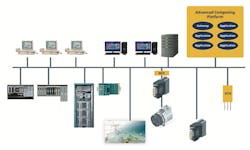Control Systems: Open Automation Gets The Green Light
The days of chemical companies struggling to integrate multiple, proprietary systems in almost every process plant or facility look numbered. The success of ongoing field trials of open-architecture-based process control systems points to a future of genuine configuration and application portability across components from different suppliers that will reduce system capital cost and total cost of ownership.
To get a sense of where things stand as well as a perspective on the implications for the chemical industry, we got inputs from experts at Endress+Hauser, ExxonMobil, Schneider Electric and Yokogawa.
At the heart of current developments is The Open Group, San Francisco, a global consortium focused on the development of open vendor-neutral technology standards and certifications. Its Open Process Automation Forum (OPAF), now has more than one hundred members drawn from operating companies, hardware and software suppliers, and system integrators. OPAF’s efforts focus on developing an open process automation standard (O-PAS).
OPAF member ExxonMobil, an early champion of such an effort, sees a clear need. Such a standard is key, explains Mohan Kalyanaraman, technology acquisition advisor, strategic planning, ExxonMobil Technology and Engineering, Spring, Texas, because working with components from different suppliers can be challenging or subject to interpretation if the vendor-specific implementations of the standard are not aligned. “However, with robust standards and conformance practices in place, compatibility is no longer an issue,” he stresses.
Fellow OPAF member Yokogawa similarly believes that if each part complies with the standard, any issues can be isolated and addressed despite the breadth of model (Figure 1).
“Although availability and long-term stability are not addressed by O-PAS, we would expect various manufacturers to offer products that are differentiated in those regards,” says Mark Hammer, global account manager, Yokogawa, Houston. “OPA actually encourages that type of differentiation with cost/benefit tradeoffs while maintaining compliance to the standards. For example, some suppliers could offer high-availability DCNs [distributed control nodes] with integral redundancy or fault tolerance while others could offer lower-priced DCNs without the redundancy or fault tolerance,” he adds.
“This topic drives home the need to have an OPA system integrator that has experience with the O-PAS standards and is working with hardware and software suppliers — both OT [operational technology] and IT [information technology] — to design and deliver a true system as opposed to a collection of components,” stresses Dave Emerson, vice president of Yokogawa’s U.S. Technology Center, The Woodlands, Texas.
Figure 1. Initiative aims to ease the tying together of diverse elements. Source: Yokogawa.
Initial Implementations
The first steps along this road came with a proof of concept (PoC) project completed at a catalyst pilot plant unit in 2018. Here, ExxonMobil, with Lockheed Martin acting as system integrator, demonstrated the attributes needed by an open system: interoperability, configuration portability, and application portability.
“We wanted to answer the question: ‘The PoC shows what is possible, but can we deploy this on an actual hydrocarbon service at high temperature and pressure and have operators run it reliably and successfully?’” says Kalyanaraman.
Later in 2018 and into 2019, ExxonMobil built a prototype system to replace a distributed control system (DCS) on a desulfurization-catalyst-testing pilot unit that ran at 600°F and 1,200 psig. The unit had 130 input/output (I/O) devices.
This prototype ran successfully for more than 12 weeks, despite needing more-robust components than those used in the PoC project. Also, because the standards were not fully fleshed out at the time, it required some customization to enable communication and control.
The combined experience gained now is being used in a field trial, one of a handful of OPAF OPA-related projects currently underway. ExxonMobil and systems integrator Yokogawa have started a FEED [front-end engineering design] field trial on a test bed at an unnamed Gulf Coast chemical manufacturer’s site.
The single-operator single-console unit has 2,000–2,500 I/O points, 90–100 closed control loops, and includes utilities, tank farms, process operations, finishing and packaging. The OPA components will be aligned with version 2.1 of the OPA standard. Data and information from the field trial process will be integrated with existing business and management systems.
All is going to plan with the test bed, which is central to derisking the associated technologies in preparation for future field trials, notes Ryan Smeltzer, OPA program manager for ExxonMobil Technology and Engineering.
“The test bed has also been a valuable environment to work with suppliers and integrators to evaluate, test, and qualify both commercial and pre-release products for potential inclusion in a field trial. These interactions, coupled with collaborative work on the standards as part of the OPA Forum, have been beneficial to moving the surrounding ecosystem forward,” he says.
Yokogawa also is pleased with the progress of the field trial FEED.
“It is going as planned. The overall process reflects the implementation of a SCADA [supervisory control and data acquisition] system rather than a traditional DCS. Like a SCADA project, the selection of the DCNs requires a collaborative effort. The implementation standards, such as graphics, need to be updated to reflect the OPA concepts, and other topics like system availability need to be redefined,” explains Hammer.
“The test bed has been a very collaborative effort with ExxonMobil and other suppliers. The concept of open and software-defined control systems is still emerging for most control hardware manufacturers. Getting their products enabled with the necessary infrastructure has been key to making the test bed work,” he adds.
While the O-PAS standard is the basis for the test bed and field work, both experts emphasize that significant effort also focuses on building out the full features expected of modern DCSs and providing functionality that goes beyond the traditional DCS.
“As an OPA system integrator, Yokogawa is executing a qualification process on current hardware and software that is being adapted to work in an O-PAS system. This work is expected to lay the groundwork for first-generation O-PAS components from different suppliers. The test-bed process provides feedback to the standards team, and the OPAF team members bring the developments into the test bed. The objective is to have products in the test bed that already meet the standards when released,” says Yokogawa’s Emerson. Several other end users are discussing possible OPA test beds and field trials with Yokogawa, he adds.
Schneider Electric, Austin, Texas, similarly is enthusiastic about the ExxonMobil field trial. Its contribution is the “plug and produce” software in the form of IEC 61499 runtime and EcoStruxure Automation Expert Soft dPAC management system.
“This represents a strong trajectory towards open process automation systems and the benefits it has for any industrial automation user, integrator, or third-party partners to leverage,” notes Nathalie Marcotte, president of Schneider Electric’s automation business.
Other Initiatives
Meanwhile, chemical makers — including BASF, Ludwigshafen, Germany; Dow, Midland, Mich.; and Saudi Aramco, Dhahran, Saudi Arabia — are taking part in other OPAF prototype projects designed to improve knowhow to scale up interoperable systems and foster future process applications.
One includes working with the User Association of Automation Technology in Process Industries (NAMUR), Leverkusen, Germany, on its NAMUR open architecture (NOA) and module type package (MTP) initiatives.
“These standards address different needs and are complementary,” explains Hammer. “While the main objective of OPA is such interoperability that allows end users or integrators to deploy systems with platforms from a variety of suppliers, NOA addresses the issue that the vast expansion of smart field devices and the ubiquitous use of IT equipment are generating significantly more data, which could make access difficult within the classic NAMUR automation pyramid. NOA introduces a second network that will not impact the automation system.”
In fact, NOA and OPAF leaders have discussed how the two approaches are complementary. Yokogawa expects to see NOA concepts, like MTP, implemented in O-PAS systems along with existing DCSs.
“The NOA goal to support modular process equipment supplied with automation capabilities and access to richer data from field instruments is in line with what end users are asking of OPAF. We expect both to become industry standards,” says Yokogawa’s Emerson.
The principle of open standards and associated initiatives at the control and field-instrument levels garners support from both suppliers and their customers.
“NOA aims to provide additional data/information from the field via a separate second channel to do maintenance and optimization without interfering directly in process control. OPA wants to break up the monolithic approach of the automation pyramid. As such, OPA defines [a] much-broader way of interaction in the control-involved nodes and systems,” notes Franz Durmeier, team leader IMI marketing intelligence, Endress+Hauser, Reinach, Switzerland.
The results already achieved in various demonstrations seem very promising for the company and its customers, he adds.
The projects listed by OPAF include: a BASF OPA demonstrator with four water tanks and managed control loops using MTP technology based on the NOA program; a Middle East OPA test-bed collaboration between Saudi Aramco and Schneider Electric based at the petrochemical company’s Dhahran innovation and research center; and a Dow Chemical MxD open-architecture test bed, which reportedly is serving to explore digital-twin concepts.
Advanced Computing Platform
Meanwhile, in parallel with the industrial projects, is a plan to bring an advanced computing platform (ACP) to market. A memorandum of understanding signed in March by Intel, Dell, Schneider, VMWare and Yokogawa commits the companies to this aim, with the ACP allowing the deployment of IT-like technologies into the OT world.
The ACP uses commercial-off-the-shelf hardware and software to deploy process control applications independent of controller hardware. It allows end users to securely deploy and manage advanced applications — control algorithms — at the lower levels of the stack close to the process edge through key features, including low latency and real-time processing.
“The ACP uses a software-defined approach to deliver OT capability, including the use of containers, virtualization, orchestration, etc. We fully expect there is more than one way to put together the ACP; thus, the focus is on functionality based on user-defined requirements and use cases,” explains ExxonMobil’s Smeltzer.
Looking further ahead, Yokogawa believes OPA will provide a range of other benefits beyond the expected savings, even before the standard is fully realized.
“The ability to easily test and implement applications, whether custom apps, AI [artificial intelligence], ML [machine learning], or advanced control, will bring more value to users. Users can also use OPA to expand existing systems taking advantage of the lower-cost hardware and virtualized environments,” says Hammer.
Figure 2. Unlocking data stranded in instruments and other devices can lead to increased efficiency and reliability. Source: Endress+Hauser.
Then, as the OPA ecosystem matures, Yokogawa envisions end users maintaining a relationship with an OPA system integrator to supply new systems and expand/replace existing DCS/PLC [programmable logic controller]/OPA systems with new components — both hardware and software. OPA also will radically change the way of thinking about automation systems: such systems will become software defined with software components/functionality being deployed to hardware that may change over time.
“Today, end users receive the greatest value from software, not control system hardware — this trend will accelerate with OPA,” concludes Yokogawa’s Emerson.
For his part, Durmeier believes access to the valuable information found in field-level devices (Figure 2) is crucial to support data-driven services for use cases around NOA.
“Field instruments already have a bunch of data available but most of it is locked in the field level today. Just imagine getting any data of the devices and of the process environment around the devices in real-time to improve processes and work efficiency of maintenance personnel. For field device manufacturers, there are also many advantages if the available field-device data beyond the process value is really used. For example, smart algorithms in the device can create a unique selling point if maintenance of a device can be predicted or prevented. Open and connected systems can provide valuable data at the right place and in the right time,” he enthuses.
On the other hand, he points out that companies in the process industries are quite conservative and often reluctant to change the way their processes are run.
Durmeier suggests end users adopting new technologies or standards should start with small evaluations — either in test labs or in plants outside of the core process. Depending on the technology, this might be very important for learning, acceptance, and internal discussions. Device manufacturers and standard organizations can support this with both test devices and expert knowledge about the technologies. Such evaluations can form the basis for creating a rollout plan.
“In general, all new technologies and standards in the context of digitalization have the same goal: increasing the efficiency of the end users,” he concludes.
About the Author
Seán Ottewell
Editor-at-Large
Seán Crevan Ottewell is Chemical Processing's Editor-at-Large. Seán earned his bachelor's of science degree in biochemistry at the University of Warwick and his master's in radiation biochemistry at the University of London. He served as Science Officer with the UK Department of Environment’s Chernobyl Monitoring Unit’s Food Science Radiation Unit, London. His editorial background includes assistant editor, news editor and then editor of The Chemical Engineer, the Institution of Chemical Engineers’ twice monthly technical journal. Prior to joining Chemical Processing in 2012 he was editor of European Chemical Engineer, European Process Engineer, International Power Engineer, and European Laboratory Scientist, with Setform Limited, London.
He is based in East Mayo, Republic of Ireland, where he and his wife Suzi (a maths, biology and chemistry teacher) host guests from all over the world at their holiday cottage in East Mayo.



